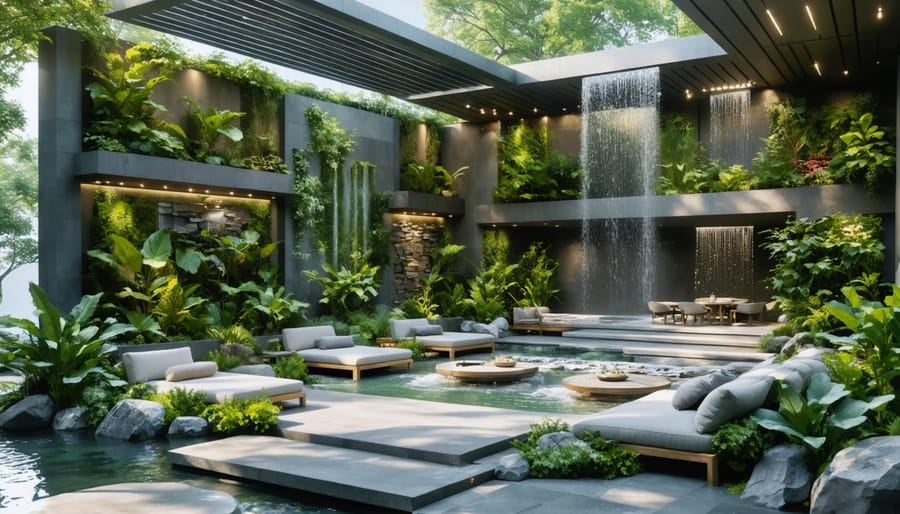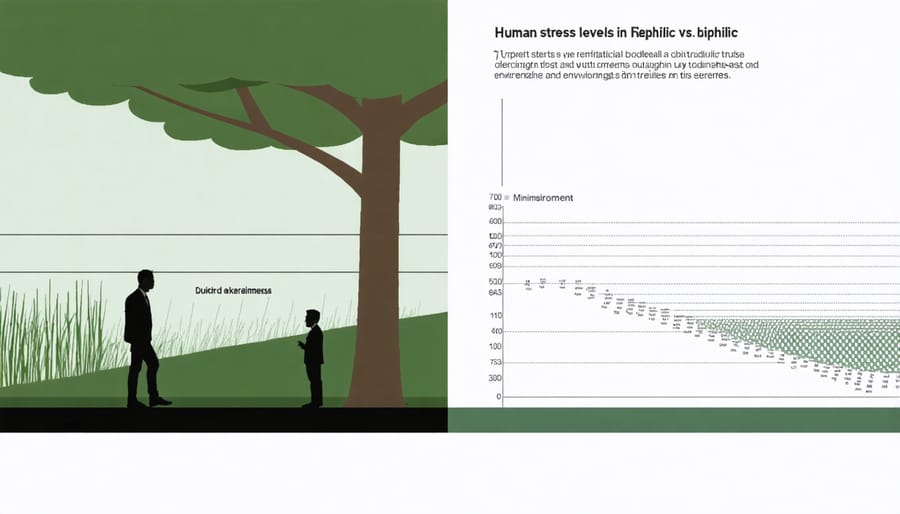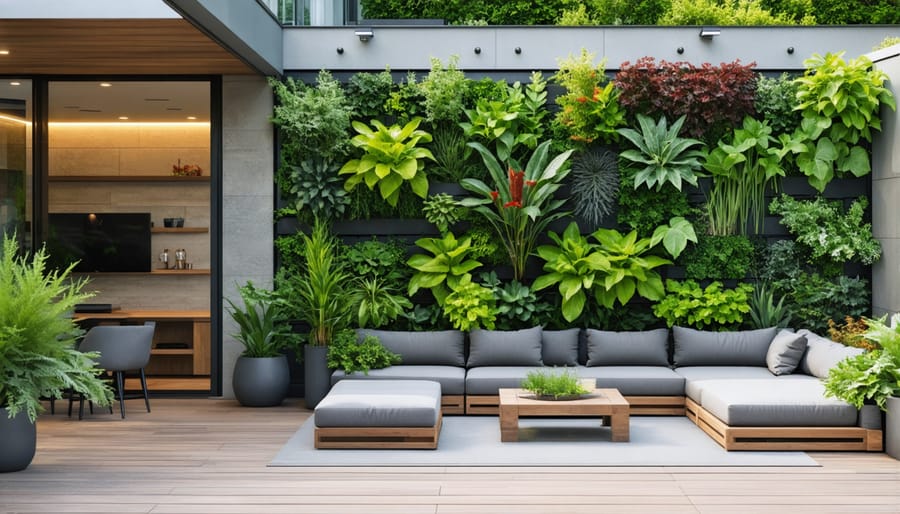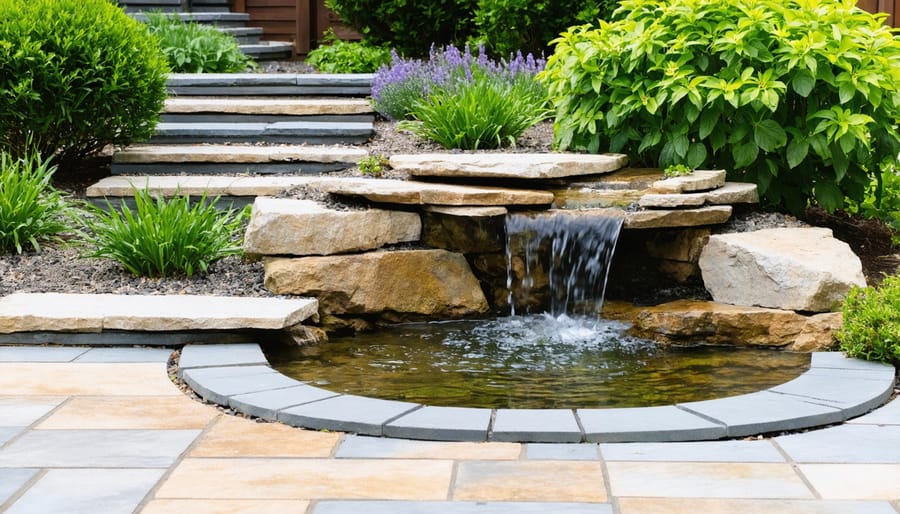Bring Nature Home: Biophilic Design Transforms Outdoor Living Spaces

Biophilic design architecture seamlessly merges natural elements with modern building practices, creating spaces that nurture our innate connection to nature while enhancing well-being and productivity. By incorporating living walls, natural light, organic materials, and water features, architects are revolutionizing how we experience built environments. This innovative approach transforms traditional structures into dynamic ecosystems that reduce stress, improve air quality, and foster creativity.
More than just a design trend, biophilic architecture responds to our growing disconnection from nature in urban environments. Research shows that spaces incorporating natural elements can reduce stress by 15%, increase productivity by 8%, and significantly improve overall mental health. From the Amazon Spheres in Seattle to Singapore’s Jewel Changi Airport, landmark projects demonstrate how biophilic design can create extraordinary spaces that benefit both people and the planet.
For homeowners and designers, biophilic principles offer practical solutions for creating healthier, more sustainable living spaces. By thoughtfully integrating natural materials, maximizing daylight, and creating visual connections to outdoor environments, any space can be transformed into a nature-inspired sanctuary that promotes wellness while reducing environmental impact.
The Science Behind Biophilic Design
Natural Elements in Outdoor Spaces
Natural elements form the cornerstone of biophilic design, bringing the calming and restorative power of nature into outdoor living spaces. Wood stands out as a primary material, with its warm tones and organic textures creating an instant connection to the natural world. Cedar, teak, and bamboo are popular choices that blend durability with aesthetic appeal.
Stone elements, whether in the form of pathways, retaining walls, or decorative features, add a grounding presence to any outdoor space. Natural rock formations or carefully placed boulders can serve as focal points while providing opportunities for seating or climbing plants.
Water features play a crucial role in biophilic design, from simple fountains to elaborate ponds. The sound of flowing water creates a peaceful atmosphere while attracting local wildlife. Living walls and vertical gardens maximize green space in compact areas, while native plants ensure sustainability and support local ecosystems.
Natural lighting is thoughtfully incorporated through strategic placement of structures and careful consideration of sun patterns. Pergolas and shade trees can create dynamic light patterns throughout the day, enhancing the space’s natural rhythm and connection to the environment.
Health Benefits of Biophilic Spaces
Research consistently shows that incorporating natural elements into our living spaces can significantly impact our physical and mental well-being. The wellness benefits of natural spaces extend far beyond simple aesthetic appeal. Studies have found that biophilic environments can reduce stress levels by up to 60% and lower blood pressure by promoting a sense of calm and connection to nature.
Spending time in these nature-inspired spaces has been linked to improved cognitive function, enhanced creativity, and better sleep quality. The presence of natural light, plants, and organic materials can boost our immune system and increase vitamin D absorption. Many homeowners report feeling more energized and productive after incorporating biophilic elements into their outdoor areas.
These spaces also contribute to better air quality by naturally filtering pollutants and increasing oxygen levels. The psychological benefits are equally impressive, with research showing reduced anxiety, improved mood, and increased feelings of happiness among people who regularly interact with biophilic environments. This makes creating nature-inspired outdoor spaces not just a design choice, but an investment in your family’s health and well-being.

Innovative Biophilic Design Features
Living Walls and Vertical Gardens
Living walls and vertical gardens represent one of the most striking applications of biophilic design in outdoor spaces. These innovative green installations transform ordinary vertical surfaces into vibrant, living tapestries that connect us with nature while maximizing limited space. Homeowners are increasingly incorporating these features into their outdoor areas, from simple trellis systems supporting climbing plants to sophisticated modular panels filled with diverse vegetation.
The beauty of vertical gardens lies in their versatility. They can be installed on existing walls, fences, or even purposely built structures, creating natural privacy screens while improving air quality and reducing ambient temperature. For those with limited ground space, vertical gardens offer an excellent solution for growing both ornamental plants and edible herbs.
Implementation can range from DIY projects using pocket planters and recycled materials to professional systems with built-in irrigation. Popular plant choices include ferns, succulents, and trailing vines, which create different textures and visual interest throughout the seasons. When planning a living wall, consider factors like sun exposure, water accessibility, and maintenance requirements.
Many homeowners report that their vertical gardens become focal points in their outdoor spaces, drawing positive attention and creating peaceful environments for relaxation. These installations not only enhance the aesthetic appeal of outdoor areas but also contribute to biodiversity by providing habitats for beneficial insects and birds.

Natural Material Integration
Natural materials serve as the cornerstone of biophilic design, creating a seamless connection between your outdoor structures and the surrounding environment. By incorporating eco-friendly building materials like reclaimed wood, natural stone, and bamboo, you can create storage spaces that not only serve their practical purpose but also enhance your property’s natural aesthetic.
Consider using locally sourced timber for shed walls and frameworks, which not only reduces transportation emissions but also helps your structure blend naturally with the local landscape. Sustainable materials like cork flooring or recycled composite decking offer durability while maintaining an organic feel. For roofing, green alternatives such as cedar shakes or living roof systems can transform your storage space into a thriving ecosystem.
Natural finishes and treatments, such as linseed oil or beeswax, protect your materials while preserving their authentic appearance and tactile qualities. These treatments allow the natural grain and texture of wood to shine through, creating a more inviting and harmonious outdoor space.
Incorporating elements like stone pathways leading to your storage area or climbing plants on trellises can further integrate your structure with its surroundings. Remember to choose materials that can withstand local weather conditions while maintaining their natural beauty over time. This thoughtful selection ensures your outdoor space remains both functional and aesthetically pleasing for years to come.
Water Features and Natural Light
Water features and natural light are two fundamental elements that can transform your outdoor space into a serene, nature-connected sanctuary. The gentle sound of flowing water creates a calming atmosphere while helping to mask unwanted noise from traffic or neighbors. Consider incorporating a small fountain, reflecting pool, or even a simple wall-mounted water feature that can be easily integrated near your storage areas.
When positioning water elements, think strategically about placement to maximize both visual appeal and practical benefits. A fountain near your seating area can provide ambient sound while serving as a focal point, while a small stream or cascade can guide visitors along pathways between outdoor storage structures and living spaces.
Natural light plays an equally crucial role in biophilic design. Implementing natural lighting solutions not only enhances the visual appeal of your outdoor space but also creates a more inviting environment throughout the day. Consider using reflective surfaces near water features to amplify natural light, and position structures to take advantage of daily sun patterns.
To maximize these elements, try incorporating light-colored materials in your hardscaping and storage solutions. Light-reflecting surfaces can help distribute natural light more effectively while creating a harmonious connection between your built structures and water features. Remember to maintain clear sightlines to water elements and ensure adequate drainage to protect nearby storage areas.
Practical Implementation Tips

Budget-Friendly Solutions
Creating sustainable outdoor living spaces with biophilic design doesn’t have to break the bank. By focusing on smart, cost-effective solutions, you can bring nature into your outdoor area without overspending.
Start with vertical gardening using recycled materials like wooden pallets or hanging planters. These not only save space but also create stunning green walls at a fraction of the cost of professional installations. Consider growing climbing plants like ivy or jasmine along existing fences or walls – they’re affordable and create an instant natural backdrop.
Incorporate natural materials found in your local environment. Use river rocks for pathways, fallen branches for borders, or repurposed wood for raised garden beds. These elements add authentic texture and connection to nature while keeping costs minimal.
Create wildlife-friendly zones using native plants, which typically require less maintenance and water. Bird feeders, butterfly-friendly flowers, and simple water features made from recycled containers can attract local wildlife without significant investment.
Transform existing structures with natural elements. Add window boxes to shed windows, install rain chains instead of traditional downspouts, or create a living roof on your garden storage unit using drought-resistant sedums. These modifications are relatively inexpensive but make a significant impact.
Consider DIY options for outdoor furniture using natural materials. Weather-resistant wooden benches, stone seating areas, or bamboo screens can be created at home, adding both functionality and biophilic elements to your space while staying within budget.
Remember to plan your design around existing natural features. Work with the natural sunlight, shadows, and wind patterns in your outdoor space to maximize the impact of your biophilic elements without additional costs.
Maintenance and Care
Regular maintenance is essential to keep your biophilic design elements thriving and beautiful throughout the year. Start by creating a seasonal maintenance schedule that includes routine cleaning of living walls, water features, and natural material surfaces. For living walls and vertical gardens, inspect plants weekly for signs of stress or disease, and ensure irrigation systems are functioning correctly.
Natural wood elements require special attention to prevent weathering and decay. Apply appropriate sealants annually and check for any signs of water damage or pest infestation. For stone pathways and features, regular cleaning with environmentally friendly solutions helps prevent moss growth while maintaining their natural beauty.
Water features need consistent monitoring to maintain proper pH levels and prevent algae growth. Clean filters monthly and remove debris regularly to ensure optimal water flow. During winter months, take necessary precautions to protect water systems from freezing damage.
Green roofs require bi-annual inspections to check drainage systems and plant health. Remove any invasive species and replace dead plants promptly to maintain coverage. Ensure structural integrity by having a professional assess the weight load annually, especially after heavy rainfall periods.
For natural ventilation systems, clean air passages seasonally and check that all mechanical components are working efficiently. Keep glass surfaces in sunrooms and garden rooms clean to maximize natural light penetration, and inspect weather sealing twice yearly.
Remember to use eco-friendly cleaning products and maintenance materials to stay true to biophilic principles. Consider keeping a maintenance log to track tasks and schedule upcoming care needs, ensuring your biophilic design features remain sustainable and beautiful for years to come.
Future-Proofing Your Outdoor Space
Creating a sustainable outdoor space that embraces biophilic design isn’t just about the here and now – it’s about planning for the future. By implementing forward-thinking strategies, you can ensure your nature-inspired outdoor area remains beautiful and functional for years to come.
Start by choosing native plants that are well-adapted to your local climate. These species require less maintenance, use less water, and provide natural habitat for local wildlife. Consider creating a diverse plant palette that includes species with different blooming seasons, ensuring year-round visual interest and supporting pollinators throughout the seasons.
Water management is crucial for long-term sustainability. Install rain gardens or bioswales to capture and filter rainwater naturally. Consider implementing a smart irrigation system that adjusts watering schedules based on weather conditions and soil moisture levels. Adding rain barrels or underground cisterns can help you harvest rainwater for dry periods.
Materials selection plays a vital role in future-proofing your space. Opt for sustainable, weather-resistant materials that age gracefully. Natural stone, recycled composites, and sustainably sourced wood not only look beautiful but also require minimal maintenance over time. These materials can withstand various weather conditions while maintaining their aesthetic appeal.
Think about adaptability in your design. Create flexible spaces that can evolve with your needs. Modular furniture, movable planters, and adjustable shade structures allow you to modify your space as seasons change or as your lifestyle evolves. Including spaces for both relaxation and productivity ensures your outdoor area remains relevant regardless of how you use it.
Don’t forget about lighting considerations. Solar-powered fixtures provide sustainable illumination while reducing energy costs. Strategic placement of trees and climbing plants can offer natural shade during summer months while allowing winter sun to warm your space.
By incorporating these future-focused elements into your biophilic design, you’re creating an outdoor space that not only connects with nature but also stands the test of time. Regular maintenance and occasional updates will keep your space fresh and functional while maintaining its natural essence for years to come.
Embracing biophilic design in your home and outdoor spaces isn’t just a trend – it’s a return to our natural roots that brings measurable benefits to our well-being. By incorporating natural materials, maximizing natural light, and creating seamless indoor-outdoor connections, you can transform your living space into a nature-inspired sanctuary. Start small by adding plants and natural textures, then gradually expand to larger elements like living walls or water features. Remember, every step toward biophilic design is a step toward better health, increased productivity, and a more sustainable lifestyle. Whether you’re planning a complete renovation or simple updates, the principles of biophilic design can guide you toward creating spaces that nurture both body and soul. Take that first step today and watch as nature transforms your home into a more vibrant, peaceful, and harmonious environment.

